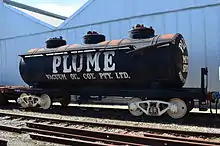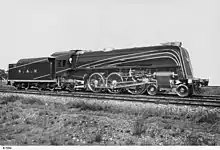Islington Railway Workshops
The Islington Railway Workshops are railway workshops in the northern suburbs of Adelaide, South Australia. They were the chief railway workshops of the South Australian Railways, and are still in operation today.[1]
| Location | |
|---|---|
| Location | Kilburn |
| Characteristics | |
| Operator(s) | South Australian Railways |
| History | |
| Opened | 1883 |
History
.jpg.webp)
The Islington workshops were established in 1883, 27 years after the South Australian Railways opened its first line. Before that, workshops were in the Adelaide Railway Station yards adjacent to North Terrace, Adelaide. A major expansion occurred from 1899 to 1902. In the 1920s, the workshops were further expanded and modernised as part of William Webb's revitalisation of the railways. From then on, the workshops constructed large numbers of bogie freight vehicles, passenger cars and designed and built modern "big power" steam locomotives and, later, diesel locomotives and railcars.
.jpg.webp)
During World War II, the workshops were involved in the construction of a number of armoured vehicles for the Australian Imperial Force, most notably the LP1, LP2, LP3 and LP4 series of armoured cars, based on Ford chassis; and the LP1 and LP2 Universal (Bren Gun) carriers.[1]
In 2012, some buildings on the site were given provisional listing as a heritage site.[2] In 2013-2014, parts of the workshops were demolished to make way for the Churchill Shopping Centre that opened in May 2014. The site includes Adelaide's first Coles Superstore. In a further expansion to the shopping centre a further part of the workshops was demolished to make room for an Aldi supermarket and a number of specialty stores.[3]
Adjacent to the workshops is the Jack Watkins Reserve, which was opened on 30 August 2003.[4] It is named after Jack Watkins, union organiser and former president of The Asbestos Diseases Society of South Australia who successfully lobbied to remove asbestos and other toxic contaminants from the railway site and adjacent properties.[4][5]
Output


The Workshops built many of the locomotives and items of rolling stock that served the South Australian Railways, including:
- 14 R class steam locomotives
- 1 Y class steam locomotives
- 78 T class steam locomotives
- 2 Z class steam locomotives
- 12 520 class steam locomotives
- 10 620 class steam locomotives
- 10 710 class steam locomotives
- 17 720 class steam locomotives
- 2 350 class diesel locomotives
- 34 500 class diesel locomotives
- 10 900 class diesel locomotives
- 12 Brill 55 railcars
- 38 Brill 75 railcars
- 18 Bluebird railcars
- 111 Redhen railcars
- 9 RL class diesel locomotives
Islington workshops also built 13 Australian Standard Garratt articulated locomotives for the Queensland Railways and Western Australian Government Railways.
Heritage listings
Nine surviving historic portions of the former workshops are listed on the South Australian Heritage Register. They are:
References
- Islington Railway Workshops Archived 2015-04-19 at the Wayback Machine SA Life
- Islington railway yards make the list Adelaide Advertiser 3 April 2012
- $100 million Churchill Shopping Centre opens on May 28 Archived 2014-06-04 at the Wayback Machine Adelaide Advertiser 28 May 2014
- "The Asbestos Diseases Society of South Australia". www.adssa-inc.com.au. Archived from the original on 22 December 2017. Retrieved 21 December 2017.
- "Jack Watkins Reserve". Monument Australia. Archived from the original on 22 December 2017. Retrieved 21 December 2017.
- "Islington Railway Workshops Chief Mechanical Engineer's Office". South Australian Heritage Register. Department of Environment, Water and Natural Resources. Archived from the original on 10 October 2016. Retrieved 15 August 2016.
- "Islington Railway Workshops Fabrication Shop". South Australian Heritage Register. Department of Environment, Water and Natural Resources. Archived from the original on 10 October 2016. Retrieved 15 August 2016.
- "Islington Railway Workshops Foundry". South Australian Heritage Register. Department of Environment, Water and Natural Resources. Archived from the original on 10 October 2016. Retrieved 15 August 2016.
- "Islington Railway Workshops Apprentice School". South Australian Heritage Register. Department of Environment, Water and Natural Resources. Archived from the original on 10 October 2016. Retrieved 15 August 2016.
- "Islington Railway Workshops Electrical Shop". South Australian Heritage Register. Department of Environment, Water and Natural Resources. Archived from the original on 10 October 2016. Retrieved 15 August 2016.
- "Islington Railway Workshops Fabrication Shop Annex". South Australian Heritage Register. Department of Environment, Water and Natural Resources. Archived from the original on 10 October 2016. Retrieved 15 August 2016.
- "Front Fence, adjacent to Chief Mechanical Engineer's Office, Islington Railway Workshops". South Australian Heritage Register. Department of Environment, Water and Natural Resources. Archived from the original on 24 May 2018. Retrieved 24 May 2018.
- "Time Office/Correspondence Room (Building 171), Islington Railway Workshops". South Australian Heritage Register. Department of Environment, Water and Natural Resources. Archived from the original on 24 May 2018. Retrieved 24 May 2018.
- "Old Bulk Store (formerly Carriage and Wagon Shop extension), Islington Railway Workshops". South Australian Heritage Register. Department of Environment, Water and Natural Resources. Archived from the original on 24 May 2018. Retrieved 24 May 2018.